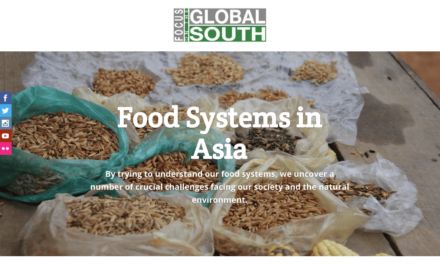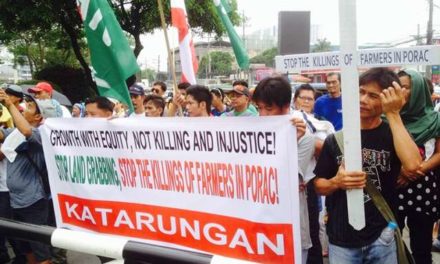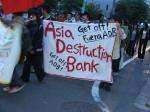By Walden Bello
The fifth summit of the Asia-Pacific Economic Cooperation (APEC) held in Vancouver in the last week of November was marked by a remarkable reversal of roles from previous meetings. During the past three summits, all of which were held on the other side of the Pacific, the East Asian governments played reluctant listeners to the United States and other non-Asian members of the trade formation who were banging on the door of the “Asian Miracle,” demanding trade and investment liberalization that would allow American and other foreign firms significantly greater penetration of their markets.
This time, the Asians were the ones making the trek across the Pacific, and they were coming cap in hand, still shellshocked by the rapid unravelling of their economies over the last five months. Except of course the irrepressible Mahathir Mohamad of Malaysia, who took the opportunity to denounce the “ideology of the market” that had reduced “vibrant economies…to begging for aid from the International Monetary Fund.” The beggar of the day was the South Korean government, whose dramatic announcement that it was seeking an IMF bailout on the eve of the APEC summit followed several days of strong denials by its officials. Even Japan was much diminished coming to Vancouver, unable to shake off its six-year-old recession and deeply embarrassed by the televised tearful breakdown of the president of the president of Yamaichi Securities, the country’s fourth largest broker, as he announced his firm’s insolvency at the very height of the APEC meeting.
This time, it was Washington’s turn to play it cautious and coy, with US officials suggesting that assistance would hinge on reform of the Asian countries’ financial sectors and liberalization of their trade regimes.
Nothing of Significance Achieved
In contrast to the drama unfolding outside the official sessions, APEC’s formal process was predictable and achieved nothing of significance. Perhaps the most noteworthy piece of business produced by the senior ministers’ meeting was the decision to pursue a program of “early voluntary liberalization” in 15 sectors, among them environmental goods and services, fish, medical equipment, and gemstones and jewellery. Everybody knew, of course, that such commitments would end up like the “individual action plans” (IAPs) mooted at the Manila meetings in 1996: non-binding aspirational statements of intent that were never meant to be implemented. In this sense, the Vancouver Summit was one more step away from Washington’s vision of a free trade area marked with comprehensive and binding rules to achieve borderless trade by the year 2020 that it foisted on the Bogor Summit in 1994.
Given this move away from a free trade area, there has been a great deal of questioning in Washington about the utility of APEC except as “a perfect opportunity to chat,” as one British paper once put it. Dr. Laura d’Andrea Tyson, former head of President Bill Clinton’s Council of Economic Advisers, disagrees that APEC has not advanced regional trade liberalization; she contends that it was the APEC leaders’ endorsement of zero tariffs in information technology by the year 2000 during the Manila Summit in November 1996 that “played the critical role in clinching a global agreement at the World Trade Organisation (WTO) Ministerial Meeting” the following month.
Nevertheless, it is clear that APEC is no NAFTA, and with Congress refusing to grant Clinton fast-track authority to facilitate the negotiation of more trade agreements, the goal of APEC becoming a free trade area is more distant than ever.
Liberalization Remains Overriding Objective
This is not say, however, that the US has given up on its overriding objective to liberalise trade and investment in the Asia Pacific region. The policy remains top priority in Washington’s view. It is the instrument of America’s design that is changing.
US officials have long regarded the complex of protectionism, mercantilism, industrial policy, and activist state intervention in the economy that envelops most of the East and Southeast Asian economies as a system that handicaps US economic interests exporting to or investing in Asia while unfairly assisting Asian firms in penetrating the US market. Thus as the Cold War wound down beginning in the mid-1980’s, Washington began to redefine its economic policy toward East Asia as the creation of a “level playing field” for its corporations via liberalization, deregulation, and privatization of the Asian economies.
It was a goal that the US pursued through various means in the late eighties and early nineties, including IMF and World Bank “structural adjustment” programs; a harsh unilateralist trade campaign employing the threat of trade retaliation to open up markets and stop unauthorised use of US high technologies; the drive to create an APEC free trade area; and a strong push on the Asian countries to implement the GATT Uruguay Round agreements that eliminated trade quotas, reduced tariffs, banned the use of trade policy for industrialisation purposes, and opened up agricultural markets.
Prior to Vancouver, the liberalization drive had brought meagre results, except perhaps in the case of Korea, whose trade surplus had been turned into a deficit. But even this development had not changed the US Trade Representative’s Office assessment of Korea as one of the world’s most protected economies in terms of trade and investment. Nor had Washington’s view of Japan changed: despite the current government’s free market rhetoric, it was seen as a market that is hard to penetrate owing to “structural impediments” like tight conglomerate relationships cutting across industries and a continuing hand-in-glove relationship between the bureaucracy and Japanese business. As for the Southeast Asian countries, the assessment in Washington was that while they might have liberalised their capital accounts and financial sectors, they remained highly protected when it came to trade and were dangerously flirting with “trade distorting” exercises in industrial policy like Malaysia’s national car project, the Proton Saga, or Indonesia’s drive to set up a passenger aircraft industry.
Washington, the IMF, and APEC
A golden opportunity to complete free market reform has now opened up with the Asia’s financial debacle, and it is unlikely that Washington will not take it. The instrument of choice has now become the International Monetary Fund (IMF). What APEC and trade unilateralism failed to achieve, the IMF, which has over the last 15 years loyally served Washington’s goal of market reform and structural adjustment in the developing world, might now be able to under conditions of crisis. Thus, the US’s strong opposition to the creation of the “Asian Regional Fund” that is not supervised and coordinated by the IMF.
In the week leading up to the Vancouver Summit, Washington was, in fact, able to kill the idea of an independent Asian fund mooted by Japan and force the adoption of an alternative facility that enshrined the supremacy of the Fund at an Asian finance ministers’ meeting in Manila. Under this plan, the terms for any bailout fund would be set by the IMF, which would also provide most of the funds. If additional support is needed, countries can contribute more funds but in consultation with the IMF. The adoption of the Washington-backed proposal by the Asian finance ministers and its endorsement by the APEC leaders over a week later in Vancouver “was seen as a defeat for Tokyo,” according to the Japan Economic Institute.
The rollback of trade and investment protectionism and activist state intervention has already been incorporated into the IMF stabilisation programs that have been negotiated or are being negotiated with Thailand, Indonesia, and Korea. Thai authorities have agreed to remove all limitations on foreign ownership of Thai financial firms and are pushing ahead with even more liberal foreign investment legislation that would allow foreigners to own land, a practice that has long been taboo in that country.
Even before it sought the help of the IMF, Jakarta abolished a 49 per cent limit for foreign investors to buy IPO shares in publicly listed companies. Also, informed opinion has it that the final agreement with the IMF will include not just the shutting down of insolvent banks but also the abandonment of attempts at industrial policy, such as the national car project of President Suharto’s son, Tommy Suharto, and the ambitious high-tech effort to manufacture passenger jets by his science and technology minister, Yusuf Habibie.
In the case of Korea, the final package negotiated with the IMF allows foreigners to buy 50 per cent shares in South Korean companies–a figure that will rise to a controlling 55 per cent in 1998–and permits foreign banks to hook up with South Korean banks in merger-and-acquisition agreements. Foreign investors are also allowed to buy up to 30 per cent of long-term guaranteed corporate bonds, a right they have been seeking for years in order to exploit a $64 billion market.
As its role as an instrument of economic liberalization diminishes, APEC is not likely, however, to vanish. Its importance as an image of “trans-Pacific cooperation” is likely to increase in order to counter or obscure the real dynamics of economic domination now unleashed on the region. We will, unfortunately, continue to be regaled by those silly pictures of 18 males in some national dress, arms-linked and smiling for the ages. It is, in fact, said that the least uninteresting question about next year’s APEC summit in Kuala Lumpur is what “national uniform” Mahathir will foist on his guests.
*Walden Bello is co-director of Focus on the Global South and professor of sociology and public administration at the University of the Philippines. He attended the recent People’s Summit on APEC that took place at the same time as the official APEC meeting.









